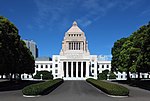Supreme Court of Japan
1947 establishments in JapanConstitutional courtsCourts and tribunals established in 1947National supreme courtsSupreme Court of Japan

The Supreme Court of Japan (最高裁判所, Saikō-Saibansho, called 最高裁 Saikō-Sai for short), located in Hayabusachō, Chiyoda, Tokyo, is the highest court in Japan. It has ultimate judicial authority to interpret the Japanese constitution and decide questions of national law. It has the power of judicial review, which allows it to determine the constitutionality of any law or official act.
Excerpt from the Wikipedia article Supreme Court of Japan (License: CC BY-SA 3.0, Authors, Images).Supreme Court of Japan
Aoyama-dori, Chiyoda
Geographical coordinates (GPS) Address External links Nearby Places Show on map
Geographical coordinates (GPS)
| Latitude | Longitude |
|---|---|
| N 35.680277777778 ° | E 139.74361111111 ° |
Address
最高裁判所
Aoyama-dori
102-0092 Chiyoda
Japan
Open on Google Maps










